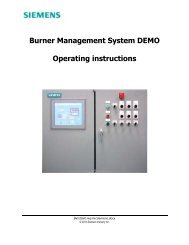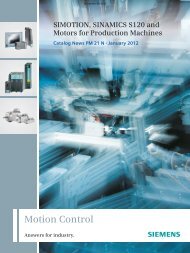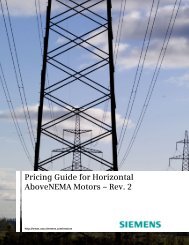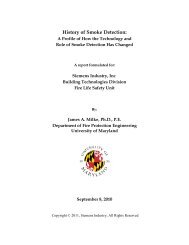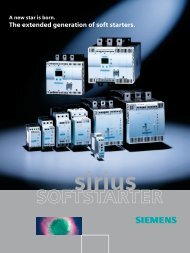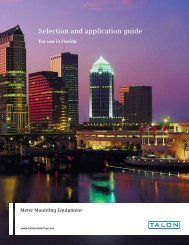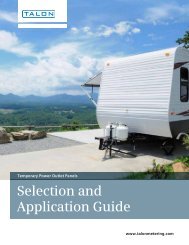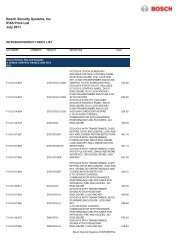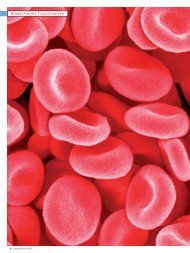Sleeve vs Antifriction Bearings - Siemens Industry, Inc.
Sleeve vs Antifriction Bearings - Siemens Industry, Inc.
Sleeve vs Antifriction Bearings - Siemens Industry, Inc.
Create successful ePaper yourself
Turn your PDF publications into a flip-book with our unique Google optimized e-Paper software.
cool the oil such the bearing speed limit can be safelyincreased.The highest horsepower rating in which anti-frictionbearings can be used is indirectly limited by the bearingspeed limit. As larger horsepower ratings areencountered, larger shaft sizes will have to be used tokeep torsional shaft stresses within acceptable levels.However, as shaft size (and thus bearing size) goes up,the bearing speed limit goes down. Eventually therequired shaft size will result in anti-friction bearings thathave a lower bearing speed limit than the motoroperational speed. At this point a sleeve bearing would berequired.Table II can be referenced as a guide for typical speedlimits for various ratings and applications [1]:TABLE IITYPICAL APPLICATION & SPEED LIMITSGreaseFrame HP Speed Application DE Brg Spd. Lim.320 50 3600 DC 6312 5000580 2000 3600 DC 6315 4300580 1500 1800 Belted NU2228 2000680 4000 1800 DC 6232 1900800 5000 1200 DC 6334 1700D. Bearing Housing and Shaft FitsBearing manufacturers provide recommendations forbearing housing and shaft fits. In general, the rotatinginner ring should have an interference fit on the shaft, andthe non-rotating outer ring, a slight clearance in thehousing. Although the bearing manufacturers providerecommendations, it is up the motor manufacturers totemper this information and determine what fits work best.Ideally, the fit with a clearance should be as loose aspossible without sacrificing vibration performance.E. Anti-Friction Bearing TemperaturesBearing temperatures vary a great deal depending onmotor design and speed. On open horizontal machines,which are identical on both ends, the bearingtemperatures on both ends of the motor will be similar. Ontotally enclosed fan cooled (TEFC) motors, the non-driveend bearing is much cooler than the drive end bearing dueto increased cooling. Most anti-friction bearings them selfhave temperature limits of 150 Deg. C (300 F) thoughtthey normally will never be allowed to run that warm. Ifthis temperature is exceeded than permanent bearingdamage may result. It is possible to get bearings that areheat stabilized to a much higher temperatures. However,bearing lubrication requirements at these highertemperatures will have to be reviewed to make sure thatthe bearing is properly lubricated at these elevatedtemperatures. The motor manufacturer can providemaximum safe bearing operating temperature taking allthese factors into account.F. Bearing Temperature DetectionThe most common method of bearing temperaturedetection is thru measurement of the outer racetemperature by a Resistance Temperature Device (RTD).This measurement of outer race temperature will providegood indication of overall bearing temperature. <strong>Antifriction</strong>bearings can fail quickly, without much priorwarning. The true benefit of temperature detection iswhen used in a trending fashion. Any unexplainablechange in bearing temperature should be thoroughlyinvestigated.G. Bearing Vibration DetectionThe most common method of bearing vibration detectionis thru measurement of bearing housing vibration. Aseismic vibration transducer (i.e. accelerometer) is mostcommonly used, and the most common units for this typeof measurement is in velocity in inches per second. It isimportant to understand the difference between RMS andpeak. Normally in the United States the velocitymeasurement is taken and expressed in inches persecond (ips) peak value. European convention is RMS(root mean square value of peak) expressed in mm persecond (mm/s). A common error is to/from convert fromips to mm/s neglecting the peak <strong>vs</strong>. RMS conversion.H. Anti-Friction Bearing LubricationIn addition to choosing the type of bearing to use one mostalso choose the type of lubrication and type of bearingcavity (cleanliness) protection. Anti-friction bearings aretypically lubricated by one of three methods: greaselubrication, oil mist lubrication, and oil sump lubrication.Motors with grease-lubricated bearings have the lowestinitial cost (compared to other anti-friction bearinglubrication methods). They however require the mostmaintenance. Additionally, this method is the mostproblematic. Over-lubrication, under-lubrication and lackof cleanliness during re-lubrication are common problemsthat impact not only cost, but motor reliability as well.Motors with oil mist lubricated bearings have very similarconstruction to motors with grease lubrication. As long asthe oil mist system is correctly set up and workingproperly, the bearings are always assured a clean supplyof lubricating oil. Although initial cost is higher, in manycases the life cycle cost is lower as the maintenancerequirements are much less. In addition, the motors seemuch greater reliability and increased mean time betweenfailures.Oil sump lubrication is usually employed when thebearings need additional cooling than what can be offeredby grease or oil mist lubrication. Typically only verticalmotors use this type of lubrication arrangement. A coolingcoil is often submersed in the oil for additional cooling.Fig. 2 illustrates such an arrangement.Page 3 of 13



